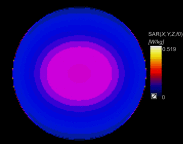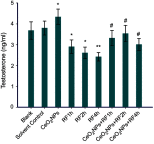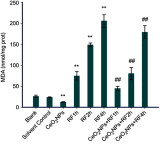CeO2NPs relieve radiofrequency radiation, improve testosterone synthesis, and clock gene expression in Leydig cells by enhancing antioxidation
- PMID: 31296989
- PMCID: PMC6598754
- DOI: 10.2147/IJN.S206561
CeO2NPs relieve radiofrequency radiation, improve testosterone synthesis, and clock gene expression in Leydig cells by enhancing antioxidation
Abstract
Introduction: The ratio of Ce3+/Ce4+ in their structure confers unique functions on cerium oxide nanoparticles (CeO2NPs) containing rare earth elements in scavenging free radicals and protecting against oxidative damage. The potential of CeO2NPs to protect testosterone synthesis in primary mouse Leydig cells during exposure to 1,800 MHz radiofrequency (RF) radiation was examined in vitro. Methods: Leydig cells were treated with different concentrations of CeO2NPs to identify the optimum concentration for cell proliferation. The cells were pretreated with the optimum dose of CeO2NPs for 24 hrs and then exposed to 1,800 MHz RF at a power density of 200.27 µW/cm2 (specific absorption rate (SAR), 0.116 W/kg) for 1 hr, 2 hrs, or 4 hrs. The medium was used to measure the testosterone concentration. The cells were collected to determine the antioxidant indices (catalase [CAT], malondialdehyde [MDA], and total antioxidant capacity [T-AOC]), and the mRNA expression of the testosterone synthase genes (Star, Cyp11a1, and Hsd-3β) and clock genes (Clock, Bmal1, and Rorα). Results: Our preliminary result showed that 128 μg/mL CeO2NPs was the optimum dose for cell proliferation. Cells exposed to RF alone showed reduced levels of testosterone, T-AOC, and CAT activities, increased MDA content, and the downregulated genes expression of Star, Cyp11a1, Hsd-3β, Clock, Bmal1, and Rorα. Pretreatment of the cells with 128 μg/mL CeO2NPs for 24 hrs followed by RF exposure significantly increased testosterone synthesis, upregulated the expression of the testosterone synthase and clock genes, and increased the resistance to oxidative damage in Leydig cells compared with those in cells exposed to RF alone. Conclusion: Exposure to 1,800 MHz RF had adverse effects on testosterone synthesis, antioxidant levels, and clock gene expression in primary Leydig cells. Pretreatment with CeO2NPs prevented the adverse effects on testosterone synthesis induced by RF exposure by regulating their antioxidant capacity and clock gene expression in vitro. Further studies of the mechanism underlying the protective function of CeO2NPs against RF in the male reproductive system are required.
Keywords: CeO2NPs radiofrequency radiation; Leydig cell; antioxidant; clock genes; testosterone synthesis.
Conflict of interest statement
The authors report no conflicts of interest in this work.
Figures










Similar articles
-
1800 MHz radiofrequency fields inhibits testosterone production via CaMKI /RORα pathway.Reprod Toxicol. 2018 Oct;81:229-236. doi: 10.1016/j.reprotox.2018.08.014. Epub 2018 Aug 17. Reprod Toxicol. 2018. PMID: 30125682
-
Luteinizing hormone signaling is involved in synchronization of Leydig cell's clock and is crucial for rhythm robustness of testosterone production†.Biol Reprod. 2019 May 1;100(5):1406-1415. doi: 10.1093/biolre/ioz020. Biol Reprod. 2019. PMID: 30722003
-
Circadian clock gene BMAL1 controls testosterone production by regulating steroidogenesis-related gene transcription in goat Leydig cells.J Cell Physiol. 2021 Sep;236(9):6706-6725. doi: 10.1002/jcp.30334. Epub 2021 Feb 17. J Cell Physiol. 2021. PMID: 33598947
-
Hormonal regulation of steroidogenic enzyme gene expression in Leydig cells.J Steroid Biochem Mol Biol. 1992 Dec;43(8):895-906. doi: 10.1016/0960-0760(92)90317-C. J Steroid Biochem Mol Biol. 1992. PMID: 22217834 Review.
-
A Brief Review on Cerium Oxide (CeO2NPs)-Based Scaffolds: Recent Advances in Wound Healing Applications.Micromachines (Basel). 2023 Apr 17;14(4):865. doi: 10.3390/mi14040865. Micromachines (Basel). 2023. PMID: 37421098 Free PMC article. Review.
Cited by
-
The Mechanisms and Management of Age-Related Oxidative Stress in Male Hypogonadism Associated with Non-communicable Chronic Disease.Antioxidants (Basel). 2021 Nov 18;10(11):1834. doi: 10.3390/antiox10111834. Antioxidants (Basel). 2021. PMID: 34829704 Free PMC article. Review.
-
Genotoxic Risks to Male Reproductive Health from Radiofrequency Radiation.Cells. 2023 Feb 12;12(4):594. doi: 10.3390/cells12040594. Cells. 2023. PMID: 36831261 Free PMC article. Review.
-
Activation of Autophagy by Low-Dose Silica Nanoparticles Enhances Testosterone Secretion in Leydig Cells.Int J Mol Sci. 2022 Mar 13;23(6):3104. doi: 10.3390/ijms23063104. Int J Mol Sci. 2022. PMID: 35328525 Free PMC article.
-
Manmade Electromagnetic Fields and Oxidative Stress-Biological Effects and Consequences for Health.Int J Mol Sci. 2021 Apr 6;22(7):3772. doi: 10.3390/ijms22073772. Int J Mol Sci. 2021. PMID: 33917298 Free PMC article. Review.
-
Circadian effects of ionizing radiation on reproductive function and clock genes expression in male mouse.Environ Health Prev Med. 2021 Oct 11;26(1):103. doi: 10.1186/s12199-021-01021-4. Environ Health Prev Med. 2021. PMID: 34635049 Free PMC article.
References
MeSH terms
Substances
LinkOut - more resources
Full Text Sources
Medical
Miscellaneous

